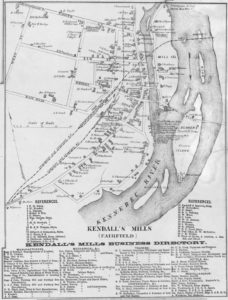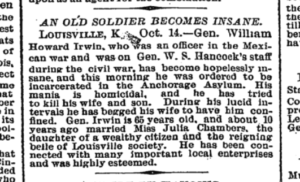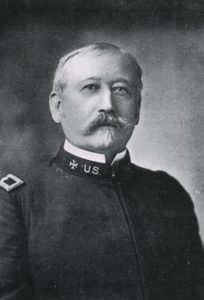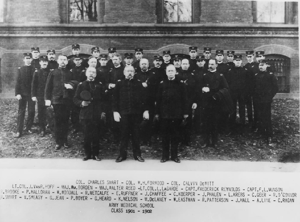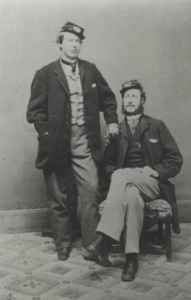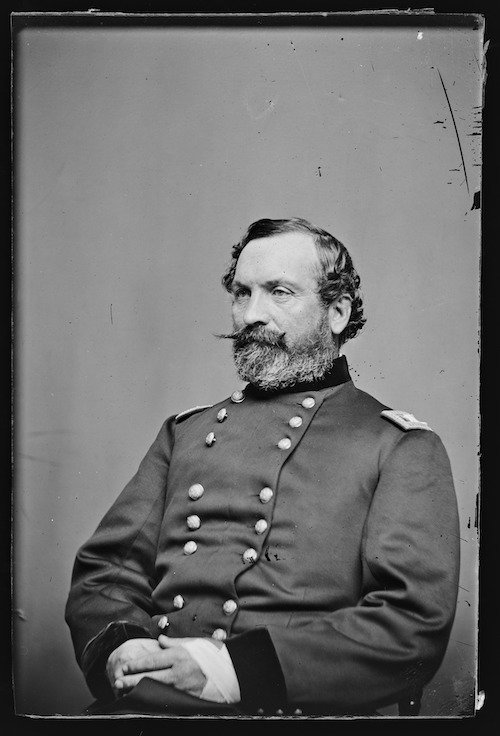Kendall’s Mills, ME (1860)
16 February 2023
Kendall’s Mills in Fairfield, Somerset County, Maine (touch to enlarge). Hometown of Lieutenant Augustus F. Emery of Companies E and D of the 7th Maine Infantry, 1861-1864.
Homes of others of the regiment are probably shown on the map. I found at least one: Seldon Connor, at Elm and Newhall Streets, was later Colonel of the Seventh (January 1864) and Governor of Maine (1876-79).
This lovely piece is but a small detail from a very large scale map of Somerset County in 1860 created by engineer J. Chase, Jr and printed by W.H. Rease in Philadelphia, PA, now at the Library of Congress.
I recommend it to my fellow students of the Regiment.
An old soldier becomes insane (1885)
10 February 2023
Colonel William Howard Irwin commanded a brigade in the Federal 6th Corps at Antietam, and is perhaps best known as the man who, possibly under the influence of alcohol, ordered a reckless charge by the 7th Maine Infantry there on Confederates on the Piper Farm.
He was wounded, sick, and “exhausted” when he resigned his commission in October 1863. He had hoped the President would appoint him Brigadier General, but that never happened …
… prior to the battle of Antietam Genl. Hancock officially recommended me for Brigadier Genl. + this was followed by the special recommendation of Major Genl. McClellan himself … My friends in the Army + Penna believe that my name has been studiously kept back from the President, or that some malignant enemy has poisoned his mind against me. You know my Dear McKean what my reputation as a soldier + a gentleman is + I know you will gladly bring my claim before the President. My military record is without a stain + altho’ I am no saint yet no dishonor or disreputable practice can be laid to my charge. Will you ask the President at once to write to me at Lewiston Pennsylvania?
He returned to the practice of law in his hometown of Lewiston, then, by 1873, moved his practice to Louisville, KY, where he married a society belle and had a son. Sadly, by 1885 his mental condition had deteriorated.
He died at the asylum in Anchorage, KY not long after at about 68 years old.
Notes
The news clip is from the New York Times of 15 October 1885.
The quotes here from a letter of his of 26 December 1862, from Baltimore, to Colonel J.B. [James Bedell] McKean, 77th New York, in Washington. It’s now at the National Archives among Letters received by the Commission Branch of the Adjutant General’s Office, 1863-1870, online via fold3 (touch to enlarge):
Willie Crosby (c. 1861)
7 February 2023
William Crosby enlisted as a Sergeant in the 7th Maine Infantry in August 1861, then an 18 year old student living with his parents and siblings in Bangor, Maine.
He was described as being 5′ 10″ tall, brown haired, with light complexion and blue eyes. No doubt about those eyes.
He was Captain of his Company by the end of the war, and also had service in the US Veteran Volunteers, and after the war, was a Regular Army officer until discharged in 1874.
This stunning photograph (touch to enlarge) is from the Maine State Archives and is online with nearly 2,500 other Civil War Era Soldiers’ Portraits through the Digital Maine project.
William H Forwood, USA (c. 1865, 1902)
5 February 2023
Dr. William Henry Forwood was an Assistant Surgeon, US Army and with the First Battalion, 14th United States Infantry at Antietam in September 1862.
His photograph is from Vol. 2 of an Army Medical Department album now in the National Library of Medicine, Bethesda, MD.
He was briefly Brigadier General and Surgeon General of the Army in 1902 at the end of his long career. Here he is then, in another picture from the NLM.
His next-to-last Army post was as President of the US Army Medical School in Washington, DC. Here he is, front and center, with the Class of 1901-02. That’s Major Walter Reed (1851-1902) third from left in the row directly behind him.
This photo from an exhibit about Reed from the National Museum of Health and Medicine.
A digital copy of a photograph at the US Army Heritage & Education Center at Carlisle Barracks, PA.
Their description is CWP 100.15: First Lieutenant Daniel Mifflin Brodhead and First Lieutenant George [Keyports] Brady, 14th Regiment, United States Infantry, in military uniforms, Brodhead is standing with his left hand on Brady’s shoulder who is seated with legs crossed.
Lieutenant Brodhead led a Company of the First Battalion, 14th United States Infantry at Antietam on 17 September 1862. Lieutenant Brady was at 2nd Bull Run in August, but not in Maryland in September 1862.
John P Shelton, 13th Massachusetts Infantry (1861)
4 February 2023
18 year old John Parker Shelton was initially only wounded in the foot at Antietam on 17 September 1862, but while helping another soldier to the rear was hit again, in the spine, and died of his wounds two days later.
… no definite information concerning young Shelton was obtained by his sorrow-stricken family for nearly three weeks after the battle. As soon as the sad tidings were telegraphed, Mr. Simon G. Cheever, – an intimate friend of the family, — started immediately for the battle-field, using every exertion to find him, or learn aught of his situation; issuing descriptive posters and scattering them throughout the region, and making all possible inquiries but to no purpose; no trace of him was learned.
Nothing was ascertained until a letter was received from Surgeon S. G. Palmer, of General Howard’s Division , who wrote from head-quarters, in camp near Harper’s Ferry, Oct. 2 – the battle was Sept. 17th — stating that young Shelton died of his wounds at the hospital on Hoffman’s Farm in the rear of that portion of the battle-field where Sumner’s corps, — to which the Thirteenth Regiment belonged, — was engaged, and where about a thousand of the wounded had been brought; — and that he had been buried in a pleasant spot beneath a walnut tree, by the side of many others, about an eighth of a mile from the farm house; at the same time sending home what few effects were found upon his body.
When these facts were learned, his cousin, Mr. Stephen W. Shelton, and his brother-in-law, Mr. George W. Copeland, at once proceeded to the battle—field and brought his body home.
Notes
This fine photograph is a carte-de-visite from the David Hann collection which he shared on Shelton’s memorial on Find-a-grave.
The quote above is from Elbridge H. Goss’ The Annals of Melrose, County of Middlesex, Massachusetts in the Great Rebellion, 1861-65 (1868).
Captain W.R. Smedberg and family
3 February 2023
Captain William Renwick Smedberg was in command of Company F, First Battalion, 14th United States Infantry in combat at Antietam on 17 September 1862. He was seriously wounded in the Wilderness in 1864 and lost his right foot to amputation, but survived the war and served another 5 years in the US Army afterward.
Here are William (standing) and his younger brother Charles Gustavus Smedberg, Jr. (1841-1863), probably photographed in 1861. Charles in the uniform of the 7th New York State Militia, William as a Private in the National Rifles of Washington, DC, before either was commissioned in the Regular Army.
William Renwick and Charles Gustavus Smedberg were the youngest of the 11 children of wealthy New York import-export merchant Charles Gustavus Smedberg (Sweden 1781-1845) and his wife Isabella Renwick (1797-1867). Charles and Isabella are seen here in a pair of 1815 miniature watercolors, probably commissioned on the occasion of their wedding, now at the National Portrait Gallery in Washington.
John Sedgwick (1862)
31 January 2023
This fine photograph, in the collection of the National Portrait Gallery in Washington, was made from an original Brady glass plate negative in the Frederick Hill Meserve Collection. It’s especially interesting to me because it pictures General Sedwick still recovering from his Antietam wounds – note the bandage visible on his hand and wrist.
For a particularly nice discussion about this picture, see a 2012 post by Ron Coddington on his Faces of War.
Musician Robert J. Robinson, 6th US Infantry
29 January 2023
Like so many soldiers of the American Civil War, County Tyrone native Robert J. Robinson died, not from combat, but from disease. He succumbed to “congestive fever” at an Army field hospital at Sharpsburg, MD on 7 October 1862 and was originally buried on the field there.
His remains were moved to the new Antietam National Cemetery in about 1867, though misidentified as Robbins rather than Robinson, as seen on this page from the cemetery History (touch to enlarge).
Perhaps doubly sad, at his death Robinson was a veteran of about 7 years Army service but had not yet reached his 20th birthday. He first enlisted as a Musician in the 6th United States Infantry in New York City in November 1855 at age 12 and reenlisted at Fort Yuma, CA in October 1860.
Update 26 April 2023: I visited Robinson’s gravesite last Friday, and got a picture of his stone. It’s somewhat worn now, but looks to have him as R.I. Robinson.
Notes
The page image above is from the Antietam National Cemetery, Board of Trustees, History of Antietam National Cemetery (Baltimore: John W. Woods, Steam Printer, 1869) from an excellent online exhibit from Western Maryland’s Historical Library (WHILBR).
Max Weber (c. 1862)
28 January 2023
Brigadier General Max Weber, formerly of the Grand Duke of Baden’s army, led a Union Brigade in an attack on the Confederate position in the Sunken Road at Antietam on 17 September 1862, and was badly wounded in the right arm in that action.
His photograph is another relatively recent acquisition for the Liljenquist Family Collection of Civil War Photographs at the Library of Congress. Touch to enlarge.
